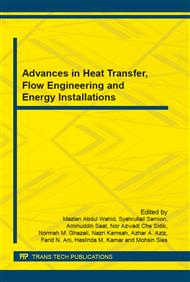p.309
p.314
p.319
p.326
p.330
p.335
p.341
p.346
p.351
Investigation of Physical and Mechanical Properties of 3-D Turbulent Flow in Orifice Pipe
Abstract:
The turbulent flow in orifice plate was investigated and solved numerically using 3-D Navier-Stockes (N-S) equations by employing commercial CFD code ANSYS. The N-S equations were solved for unsteady flow of an orifice plate at different values of Reynolds number, Re=ρVDμ, and different aspect ratios, β=dorificedpipe. Physical parameters such as velocity, differential pressure, and vorticity and mechanical properties such as stress, strain, and total deformation were examined for Reynolds numbers of 10000, 20000, and 30000 and at aspect ratios β of 0.2, 0.4, and 0.6. It was found that as Reynolds number increases, the velocity increases while the differential pressure shows very steep jump across the orifice. As aspect ratio increases, the maximum pressure declines. The vorticity patterns show that images of very condensed lines. At certain aspect ratio, the differential pressure increases as Reynolds number increases.
Info:
Periodical:
Pages:
330-334
Citation:
Online since:
January 2016
Keywords:
Price:
Сopyright:
© 2016 Trans Tech Publications Ltd. All Rights Reserved
Share:
Citation:


